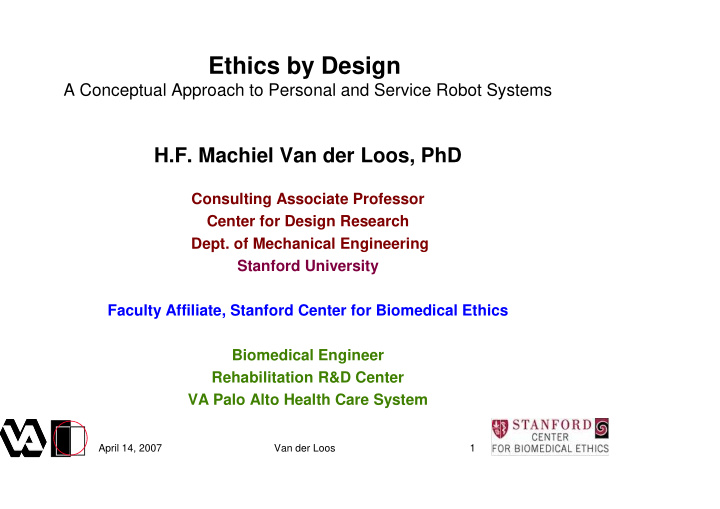



Ethics by Design A Conceptual Approach to Personal and Service Robot Systems H.F. Machiel Van der Loos, PhD Consulting Associate Professor Center for Design Research Dept. of Mechanical Engineering Stanford University Faculty Affiliate, Stanford Center for Biomedical Ethics Biomedical Engineer Rehabilitation R&D Center VA Palo Alto Health Care System April 14, 2007 Van der Loos 1
Table of Contents � Robot Design and History � Safety and the Culture of Prototyping � Believability, Safety and Ethics � Neurotechnologies as Robot Interfaces � Conclusion April 14, 2007 Van der Loos 2
Design of Robots through History � The Vision of Design � Deceptive automata of the past � Fictional humanoids of the present � Assistive robots of the future QuickTimeª a TIFF (Uncompre are needed to se Von Kempelen’s I,Robot, Chess-playing Robot, 1770 Wakamaru, Mitsubishi 20th Century Fox, 2004 Heavy Industries, 2005 April 14, 2007 Van der Loos 3
Design of Robots through History � Real humanoid robots are changing the equation � Focus on basic functionality � Explore human-robot interface issues � Embody a transparency of action QuickTimeª and a TIFF (Uncompressed) decompressor are needed to see this picture. Maillardet’s Writing Honda’s Asimo Karakuri Tea-serving Robot, 1700s Robot, 1805 Robot, 2000 The word 'Karakuri' means a "mechanical device to tease, trick, or take a person by surprise". It implies hidden magic, or an element of mystery. April 14, 2007 Van der Loos 4
Design and Safety Probot, Imperial College, UK, 1990 Puma 560, 1985 TIFF (Uncompressed) d are needed to see this QuickTimeª and a � Industrial robots used to prototype new application areas � Special-purpose prototypes � Mechatronic products DaVinci, ISI, 2005 April 14, 2007 Van der Loos 5
Post-Stroke Therapy Robots Driver’s SEAT, 1995 MIME, Puma 560, 1990 Reo™Pro ReoTherapy, Inc., 2007 April 14, 2007 Van der Loos 6
Reharob, Fiziorobot QuickTimeª and a Cinepak decompressor are needed to see this picture. �������������������������������������������������� http://www.manuf.bme.hu/Projects/FIZIOROBOT_projekt_info.ht m April 14, 2007 Van der Loos 7
Factors in Safety and Design Mechanical Design Electronics (redundancy) Control (multi-DoF) Software Architecture (RTOS) Task / Planning Behavior, Interaction (Brooks, Croft) Ethical Models (McLaren, Scasselati, Gips) April 14, 2007 Van der Loos 8
Safety and Believability � Successful believability emerges from interactions in shared experiences � Transparency of action is a prerequisite M. Masahiro, The uncanny valley (translated by K. F. MacDorman and T. Minato) , Energy, 7 (4), 1970, pp. 33-35. for trust April 14, 2007 Van der Loos 9
Which would you trust more? QuickTimeª and a decompressor are needed to see this picture. Honda Asimo, 2006 Sony SDR, 2003 Yushihiro Kuroki April 14, 2007 Van der Loos 10
“Let the body do the thinking” * MIT COG Project: Domo � Anthropomorphic arm design � RTOS design employs “ready-to-hand”, “present- at-hand” duality. QuickTimeª and a TIFF (Uncompressed) decompressor are needed to see this picture. � Human-like gesture design for effective communication * A. Edsinger, C.C. Kemp, Designing robots that assist people in everyday manual tasks, ICAR’07, Aug. 21-24, 2007, Jeju Island, Korea April 14, 2007 Van der Loos 11
Neurotechnologies and Robot Interfaces Matthew Nagle and Braingate http://cyberkineticsinc.com QuickTimeª and a TIFF (Uncompressed) decompr are needed to see this picture. Matthew Nagle and Braingate http://cyberkineticsinc.com QuickTimeª and a Kevin Warwick and arm implant TIFF (Uncompressed) decompressor (1998) are needed to see this picture. http://www.kevinwarwick.com April 14, 2007 Van der Loos 12
External Brain Machine Interfaces Record: Benjamin Blankertz, Guido Dornhege, Matthias Krauledat, � EEG Klaus-Robert Müller, Volker Kunzmann, Florian Losch, and Gabriel Curio. The Berlin � EOG Brain-Computer Interface: EEG-based communication � EMG without subject training. IEEE Trans. Neural Sys. Rehab. Eng., 14(2):147-152, 2006. Stim: http://youtube.com/watch?v=yJXT88FBQWM � TMS � tDCS James Gips and Peter Olivieri, � FES EagleEyes: An Eye Control System for Persons with Disabilities, Eleventh � ECoG QuickTimeª and a International Conference on TIFF (Uncompressed) decompressor Technology and Persons with are needed to see this picture. � DBS Disabilities, Los Angeles, California, March 1996. April 14, 2007 Van der Loos 13
Internal Brain Machine Interfaces � Deep brain stimulation (DBS) � ElectroCorticoGram (ECoG) � Cortical surface neural arrays QuickTimeª and a TIFF (Uncompressed) decompressor are needed to see this picture. Activa (Medtronic, Inc.), Parkinson’s Disease Foundation http://pdf.org J.V. Rosenfeld, Epilepsy surgery, hypothalamic hamartomas and the quest for a cure, RACS/RCSEd meeting in Adelaide, May 2002. April 14, 2007 Van der Loos 14
Bioethics and Design Challenges � Transparency of action � Interfaces � Social cues � Connectivity with other agents � Sensation - perception � Intention - action ? April 14, 2007 Van der Loos 15
Final Thoughts Michael Fincke, astronaut, said of the Star Trek Enterprise cast and crew: "Science fiction, in general, has inspired … all humans by … and nightmares. giving form to our dreams …” http://www.space.com 5/13/2005 SCIFi: • thought experiments for bioethics study. • plausible future scenarios for society to test-drive. April 14, 2007 Van der Loos 16
Acknowledgments Stanford University: Ethical Dimensions in Neuroscience Program of the Stanford University BioX Interdisciplinary Initiative http://roboethics.stanford.edu Stanford Center for Biomedical Ethics http://scbe.stanford.edu http://neuroethics.stanford.edu Center for Design Research http://cdr.stanford.edu VA Palo Alto Health Care System: Rehabilitation Research & Development Center http://ability.stanford.edu For more information: email: vdl@stanford.edu April 14, 2007 Van der Loos 17
Culture and Ethics Will personal robots begin to define a new social artifact and operating affordances and norms? OR Will the similarity of their form and function to humans dictate that robots use human behavior, culture and ethics? April 14, 2007 Van der Loos 18
Recommend
More recommend